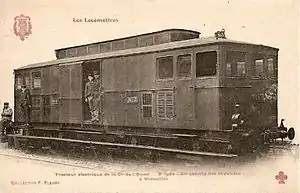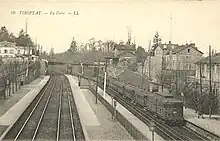 Z 5010 | |||||||||||||||||||||||||||||||||
| |||||||||||||||||||||||||||||||||
| |||||||||||||||||||||||||||||||||
| |||||||||||||||||||||||||||||||||
| |||||||||||||||||||||||||||||||||
The BB 1800 were motor luggage vans of SNCF. These were the so-called "first-series" Z 5000 locomotives ordered by the Chemins de fer de l'Ouest. They were put into service, with running numbers Z 5001 to Z 5010, on 12 April 1900, on the line from Paris-Invalides to Issy-Plaine, which was extended to Meudon on 1 July 1901 then to Versailles RG on 31 May 1902.
Description

The locomotives consisted of a wooden body covered with sheet metal and resting on a steel frame. Two large driving cabs, which also contained some of the electrical equipment, flanked a large baggage compartment. Two large sliding doors, one on each side, gave access to the baggage area.[1]
All the locomotives had four traction motors, each with a continuous power rating of 92 kW (123 hp). Two transmission techniques were tried: five machines had Postel Vinay geared transmission and the other five had direct transmission by Brown-Boveri. Equipped with contact shoes for operation on 600 V DC third rail they were never converted for operation on 1,500 V DC catenary.
Z 5002, having been damaged by fire, was written off in 1907. From 1932, the nine remaining locomotives were modified: their motors were replaced by those recovered from État 1001 – 1018, withdrawn in 1927, they received Sprague-Thomson electrical equipment and their clerestory roofs and the long wooden steps were removed.[2]
Career and services
The line from Paris-Invalides to Versailles-Rive-Gauche was progressively electrified by a third rail supplied with direct current, initially at 550 V then later uprated to 600 V, between April 12, 1900 and 31 May 1902.[3]
Assigned to Paris-Champ-de-Mars depot as soon as they were put into service in 1901,[4] the Z 5000 class thus provided the first regular services on an electrified line in France[5] and, as soon as they entered service, their performance far exceeded the requirements of the specifications.[1]
In later years these locomotives hauled, amongst other things, short rakes of 4 OCEM Talbot cars, each rake consisting of three intermediate cars and a driving trailer, on the line from Puteaux to Issy-Plaine, from 1937 to, at least, 1942.
Initially classified as self-propelled luggage vans, Z 5001 to 5010, when they were put into service, they were renumbered as locomotives BB 001 to BB 010 in 1932 then BB 1801 to BB 1810 in 1950.[5] At the end of their career, they were confined to shunting work inside the depot and were withdrawn by 1956.[6] Their revenue services were taken over by Z 5100 multiple units.
References
- 1 2 Dupuy 2008, p. 10.
- ↑ Dupuy 2008, p. 10-11.
- ↑ Dupuy 2008, p. 7.
- ↑ Fieux, Loic (February 2004). "l'art de composer les trains, les automotrices". Correspondances Ferroviaires. 3: 2–3. Retrieved 13 May 2021.
- 1 2 Dupuy 2008, p. 11.
- ↑ van Uden, Marco. "SNCF withdrawn dc electric locomotives". Railfan Europe. Retrieved 14 May 2021.
Bibliography
- Jacques Defrance (1978). Le matériel moteur de la SNCF (SNCF motive power). La Vie du rail.
- Dupuy, Jean-Marc (2008). "The BB 900/300: the BB 1800, BB 800, BB 900, BB 301 to 324, BB 325 to 355 = Supplement No. 56 to the magazine "Le Train"". Le Train. Spécial. Publitrains. ISSN 1267-5008.